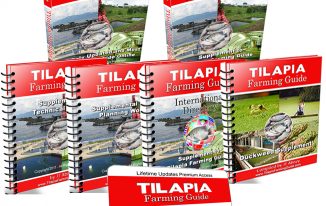Commercially tilapia is a very important fish. Globally, the fish ranks third after the carp and salmon fishes. Here in this article, we will discuss how to start a commercial tilapia fish farming business for profit.
You can grow tilapia both in ponds and tanks. Even, you can grow tilapia fish in floating cages. However, here we have shared information specifically for pond culture.
Almost all types of people across the world prefer tilapia recipes. Basically, tilapia is one of the very tasty and fast-growing fish species. Therefore it creates a great demand for both fish farmers and consumers. Additionally, tilapia fishes can survive in a wide range of environmental conditions.
Here are the 6 Steps to Start Tilapia Fish Farming
Any individual can start a tilapia fish farming business on a small-scale or large-scale basis according to his or her investment capacity. Commercial fish farming is financially successful in each case.
1. Acquire Skills for Farming Tilapia Fish
First of all, commercial farming demands some sort of skill, knowledge, and expertise. Therefore, it is advisable to have some experience before starting your own business. You can also contact the state fishery departments for tilapia farming training.
Check your state law for tilapia fish farming. Check whether the Govt. gives permission or not for commercial farming.
Basically, tilapia farming includes three broad steps. These are hatching, rearing, and harvesting. According to your investment capacity, plan for the starting point. Decide whether you will go for hatching or procure the fingerlings from other hatcheries.
2. Understand the Feasibility of Starting a Tilapia Fish Farm
It is essential to gather adequate information regarding the local demand for tilapia fish. Do market research and know the local competition, pricing, and consumption volume of the immediate market.
3. Create a Business Plan
Craft a business plan. Like any other livestock business, you can’t expect a return soon after starting the business. Hence, you must have financial preparation for that.
Before initiating, study the local market demand. Tilapia has both the domestic and export market. However, you have contact with the fish processing units for exporting the processed fish.
4. Setting up a Tilapia Fish Farm
a) Select a Farming Method
The female tilapia can produce minnows numerous times in a year. Therefore, you can find different-sized tilapia fishes in the pond. As a result, you won’t get the desired product. On the other hand, the growth rate of male tilapia is more than females.
Therefore, it is advisable to cultivate only male tilapia fishes for generating more production volume. This type of farming is called mono-sex farming. Basically, these fishes consume supplementary feed and can survive in adverse natural conditions

Therefore, it is advisable to cultivate only male tilapia fishes for generating more production volume. This type of farming is called mono-sex farming. Basically, these fishes consume supplementary feed and can survive in adverse natural conditions.
In addition to this, decide whether you will go for hatching for produce siblings at your farm or you will procure the siblings from other hatcheries. The tilapia hatching process is delicate and complicated. If you are a beginner, it is advisable to procure siblings from reputed hatcheries.
b) Pond Selection for Tilapia Fish Farming
The selection of the right pond is one of the most important aspects you must consider carefully. Ensure that, you have sufficient chlorine-free clean water availability.
Additionally, check the PH balance of the water. Generally, a pH level of 6 or 8 is ideal for tilapia. In addition, make sure that the pond is weed-free and has sufficient sunlight during the daytime. Tilapia fish can survive in 12-40 degrees centigrade temperature and grows well in 16-35 degrees centigrade temperature.
c) Select Tilapia Species
The most common breed of tilapia farmed around the world is the Nile Tilapia/Nile Perch, which accounts for roughly 75% of farmed Tilapia. Other common tilapia species include Mozambique tilapia, and Blue tilapia. Most farmers choose to keep only male tilapia in the grow-out stage. Male tilapia have proved to be more profitable as they grow bigger and are more time and energy-efficient.
Choose the appropriate tilapia species based on your climate, market demand, and farming system. Consult with local experts or fisheries departments for guidance.
d) Source Fingerling
Contact local reliable hatcheries or breeders and buy high-quality fingerlings. You need to be careful to procure healthy, disease-free fingerlings that are suitable for your farming conditions. Furthermore, quarantine the new stock before introducing them to your farm to prevent disease outbreaks.
e) Tilapia Fish Pond Management
First of all, keep the minnow of tilapia fish in a nursing pond after bringing them from the hatchery. Keep a net around the pond to prevent the fish from predators like frogs and snakes.
After 5-7 days of applying fertilizer, stock 21-28 day old minnow in the pond. Serve 10-15% feed to the fish according to the weight of the minnow. After 40-60 days of caring and nursing move them to another pond.
Successful tilapia farming demands clean water, oxygen, food, light, and room to swim. The art of tilapia farming is to understand each of these needs, and then find a way to provide them in sufficient quantities.
f) Tilapia Fish Breeding
The breeding process of tilapia fish is not so difficult and the setup of the breeding process is very simple. Also, there are several methods you can try for breeding according to the desired quantity output. For best hatchery practice it is sensible to stock one male to three females. After hatching, collect the fry and move to grow-out ponds.
g) Feeding of Tilapia Fish
Basically, tilapia is an omnivorous fish species. Usually, they consume everything including algae and various types of aquatic plants. You can give them self-made feeds or commercial feeds. However, commercial feeds are very healthy and effective for the fish and it provides the highest growth.
h) Water Management & Care
Experts do not recommend polyculture activity for tilapia, like rearing tilapia with other carp fishes. Do not put snails, shrimp, goldfish, or any other living organisms, in your tilapia pond water. Avoid conditions that cause weakened immune systems in tilapia. Such as stress due to overcrowding, poor nutrition, and high levels of nitrates. Overall, maintain clean conditions around ponds. Prevent pets, and other animals, from drinking from your tilapia pond water.
Also Read: Commercial Catfish Farming Business
i) Harvesting
Generally, 300 to 500 gm is the perfect body weight for selling tilapia fish in the market. When the stocks reach the salable body weight, catch all the fish from your pond and sell them. The harvesting time typically ranges between 6 to 9 months, depending on the species and farming conditions.
After proper sanitization, you can keep fresh stocks for further tilapia fish farming.
5. Buy Equipment & Feeds
Check the equipment list. And procure the equipment and tools as per your specific requirements. Finally, check the availability of good quality fish feeds. You must provide quality feed for faster growth.
6. Cost & Profits
Generally, the business demands two different types of investments. These are fixed costs and working capital costs. Basically, fixed cost includes purchasing the water body, equipment, and tools. On the other hand, the working capital cost includes procuring fingerlings, feeds, medicines, labor, transportation, and other investments.
Tilapia Farming Guide…Everything you need to know about setting up your own profitable Tilapia farm – all in one place.
Tilapia can survive on a diversity of food. Basically, algae are their most common food in the wild. On fish farms, they are fed a high-protein pelleted feed. When raised in a controlled environment they can achieve growth rates of up to 3 percent of body weight per day. Due to these reasons, tilapia brings handsome profits for the farm owners.
The Tilapia Business is a multi-billion dollar business at present. You don’t need any special skills or qualifications to start this business.
Frequently Asked Questions
What is the best water temperature for tilapia farming?
Tilapia thrives in water temperatures between 75°F and 86°F (24°C and 30°C). However, different tilapia species have varying temperature tolerances, so it’s important to choose a species suitable for your local climate.
How many tilapia can I stock in a pond or tank?
Stocking density depends on factors such as water quality, feeding efficiency, and the size of your pond or tank. As a general guideline, you can start with 1,000 to 1,500 tilapia fingerlings per acre of pond or 10 to 20 tilapia per cubic meter of tank.
What are the common diseases that affect tilapia?
The most common diseases in tilapia farming include bacterial infections, parasitic infestations, and viral diseases. You need to take proper biosecurity measures, regular health monitoring, and consult with aquaculture experts to prevent and manage diseases.
Can I sell live tilapia or only processed fish?
You can sell live tilapia or processed fish, depending on local market demand and your business type. Live sales may include stocking ponds or selling fish directly to consumers. On the other hand, processed fish can be sold as whole fish, fillets, or value-added products.

Editorial Team at 99BusinessIdeas is a team of experts led by Rupak Chakrabarty with over 25 years of experience in starting and running small businesses. Started in 2010, 99BusinessIdeas is now one of the largest free small business resources in the industry.
